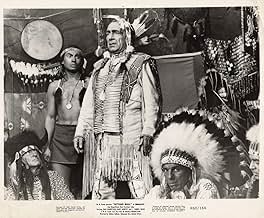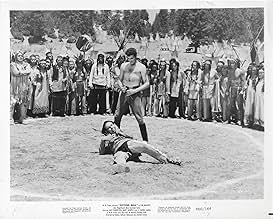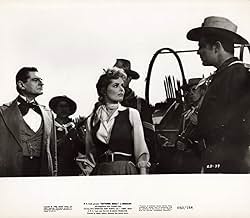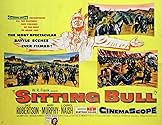Ajouter une intrigue dans votre langueA cavalry officer sympathetic to the wronged Sioux fixes a meeting between Chief Sitting Bull and President Grant but a dishonest Indian Agent and a hateful General Custer test the Sioux's p... Tout lireA cavalry officer sympathetic to the wronged Sioux fixes a meeting between Chief Sitting Bull and President Grant but a dishonest Indian Agent and a hateful General Custer test the Sioux's patience, threatening to derail the peace-talks.A cavalry officer sympathetic to the wronged Sioux fixes a meeting between Chief Sitting Bull and President Grant but a dishonest Indian Agent and a hateful General Custer test the Sioux's patience, threatening to derail the peace-talks.
- Réalisation
- Scénario
- Casting principal
- Charles Wentworth
- (as Bill Hopper)
- Webber - Indian Agent
- (as Tom Brown Henry)
- White Cloud
- (non crédité)
- Trooper Foster
- (non crédité)
- Young Buffalo
- (non crédité)
- Trooper
- (non crédité)
- Capt. Swain
- (non crédité)
Avis à la une
There's a traditional romance thrown into the mix, between a General's daughter (MARY MURPHY) and Robertson, with rival suitor WILLIAM HOPPER as another man interested in Murphy. J. CARROL NAISH is Chief Sitting Bull, who wants peace and refuses to put on his war paint although some members of his tribe are anxious to fight some of the white men's injustices. DOUGLAS KENNEDY is flamboyant and seriously miscast as the yellow-haired General Custer of the 7th Cavalry.
It's handsomely produced in outdoor settings that look authentic, but the stilted dialog is handled indifferently by a lackluster cast of players. DALE ROBERTSON gives a leaden performance in the major role and he doesn't get much help from WILLIAM HOPPER or MARY MURPHY, who in real life, married Robertson after this film. Their chemistry on film fails to register and her motivations throughout are sketchy, to say the least.
A major plot development has President Grant helping Robertson when he is condemned for helping Chief Sitting Bull and there are a few other subplots before we get to the battle at Little Big Horn. Robertson's compassion for the redskins almost lands him in big trouble toward the end, until Chief Sitting Bull intercedes just before he's about to be executed for treason by a firing squad.
Good western should have been much better but is marred by dull performances and uninspired direction of Sidney Salkow. The director unwisely allowed few close-ups of his cast throughout the film, depending solely on medium shots for most of the scenes, probably because he was new at the CinemaScope process. Since most of the cast underacts considerably, this is a real drawback in the more intimate moments.
The story involves the efforts of the fictional Major Bob Parrish (Dale Robertson) and Sioux Chief Sitting Bull (J. Carroll Naish) to prevent a war between the Sioux nations and the U.S. Cavalry. On one side, Sitting Bull's chiefs led by Crazy Horse (Iron Eyes Cody) and Colonel Custer (Douglas Kennedy) on the other push their superiors into war.
The requisite love triangle involves Parrish, the General's daughter Kathy (Mary Murphy) and newspaperman Wentworth (william Hopper). Kathy turns away from Parrish when he is charged with insubordination and reduced in rank to Captain. She then becomes engaged to Wentworth.
Parrish meanwhile with the assistance of former black slave "Sam" (Joel Flueller)arranges a meeting between President U.S. Grant (John Hamilton) and Sitting Bull. However, before the meeting can take place several incidents occur and war breaks out culminating with Custer's last stand at the Little Big Horn.
J. Carroll Naish lends dignity to his portrayal of Sitting Bull. We see him as an intelligent caring and cautious leader who will stoop to war only as a last resort. In a move unusual for its time black actor Joel Flueller was cast in one of the leading roles in the film.
The battle scenes are spectacular and well staged by director Sidney Salkow. In spite of the contrived Hollywood ending, this western is a lot better than some would have you believe.
During the movie, I was also struck by the lush score. Naturally, the TV network didn't have the decency to show all the credits, but to my ear it sounded like the outstanding work of Raoul Kraushaar -- and praise all the gods of technology for IMDb, I was right.
In my opinion, he is a terribly under-rated composer. Even the cheapest Allied Artists movies attain the ranks of quality when he wrote the score.
J. Carroll Naish as the title character is another under-rated actor. That is, he does not seem to be known among viewers although apparently he was never out of work. He almost always played some accented character, some Latin or European or, as in this case, "Indian" character. And he was almost always extremely believable.
The rest of the cast, from the excellent Dale Robertson to the excellent John Hamilton, were almost uniformly perfect.
This B film from MGM is yet another version of the events of surrounding the Little Big Horn battle where Douglas Kennedy as Custer got himself surrounded and massacred by some angry Sioux Indians. This version does show the Indian side of the events, how badly treated they were on reservations, how the whites once word of gold being discovered in their sacred Black Hills of Dakota territory systematically broke the treaties signed. Yet in fact the film went a bit overboard with presenting the Indian side and took great liberty with the facts.
Dale Robertson's an army major who zealously follows his orders about respecting the Indian rights, to the dismay of former General now Colonel George Armstrong Custer. Robertson's maverick tendencies wouldn't be liked in the army in any event, but his fiancé Mary Murphy who is General John Litel's daughter wants an upwardly mobile career man and Robertson doesn't look like a good bet. For standing on his beliefs Robertson loses her to newspaper reporter William Hopper.
But Dale gets himself in an even bigger jackpot. He's got an agreement with his former commander Ulysses S. Grant who is now president of the United States, the big chief of all the white folks. But when Custer moves prematurely and gets massacred and troops are sent on reprisal, Robertson does a very daring and potentially foolish thing to keep the peace process alive. That's the essence of our story.
Which of course never did happen. Neither did Ulysses S. Grant as played by John Hamilton on hiatus from the Superman series ever come west to negotiate with J. Carrol Naish as Sitting Bull. That's the biggest flaw in this film.
Murphy's character doesn't ring true either. From a woman who makes no bones about her desire for an upwardly mobile man, she does an about face and would make Tammy Wynette proud if Tammy had in fact ever seen Sitting Bull.
The film's heart is the in the right place, but the rest of it is out to lunch.
Though I will say one thing. If what I read is true about Mary Murphy's bout with Montezuma's revenge on location for this movie, she may have given one of the great performances of all time just getting through this film without a hint on screen.
Le saviez-vous
- AnecdotesThe film was shot outside of Mexico City, and star Mary Murphy caught "Montezuma's Revenge" and was very ill throughout the six-week shoot. Most of her scenes are relatively brief, possibly because of this.
- GaffesIn many of the scenes the women are obviously men.
- Citations
Sitting Bull: I have wanted peace. I have prayed for peace. There have been battles. But when the white soldiers win a battle, they call it victory. When the Indians win, they call it massacre.
- Crédits fousDuring the opening titles, the film's 'Technical Advisor and Indian Costumes' is credited to 'Iron Eyes Cody' who is also parenthetically credited as being a '(Famous T.V. Star)'.
- ConnexionsFeatured in Le Massacre des Sioux (1965)
- Bandes originalesGreat Spirit
Music and Lyrics by Max Rich
Meilleurs choix
- How long is Sitting Bull?Alimenté par Alexa
Détails
Box-office
- Montant brut aux États-Unis et au Canada
- 1 500 000 $US
- Durée1 heure 45 minutes
- Mixage
- Rapport de forme
- 2.55 : 1
Contribuer à cette page




































